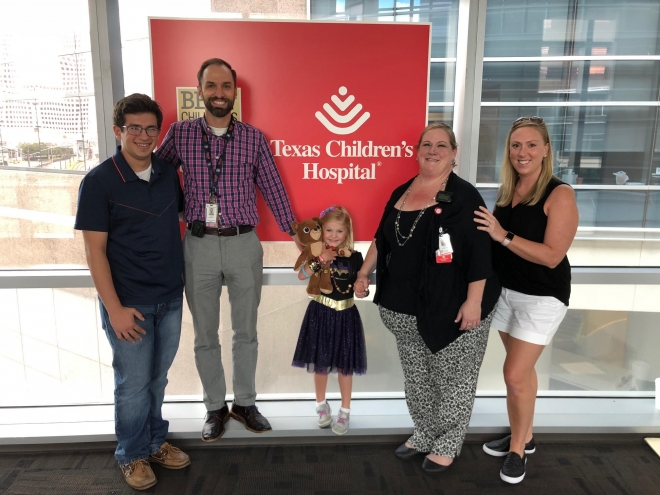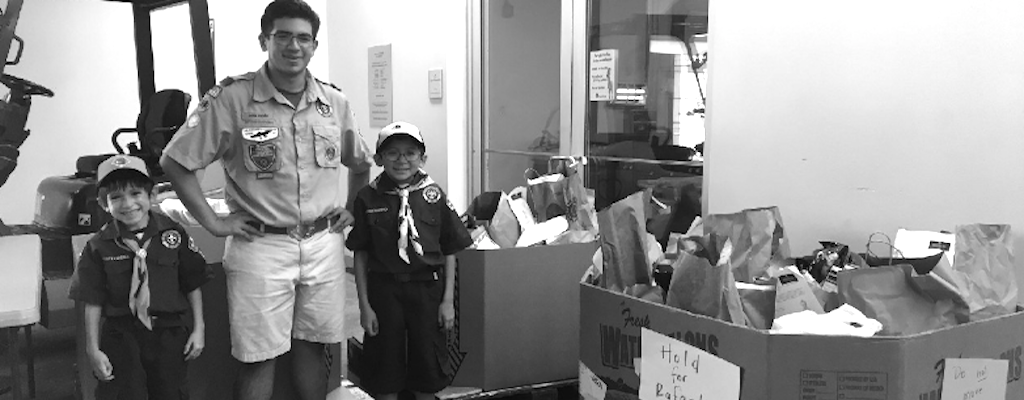A Jerry the Bear for Every Child at Texas Children’s Hospital
Living. The definition of the word is quite subjective. But for someone with type 1 diabetes, learning what that word means beyond the illness is one of the most crucial aspects of our lives. My journey began much later than others, in 2015, but the challenges I faced trying to accept the new lifestyle are all too common. The constant finger-pricking, the constant temptations from high-carb foods and the frequent low blood sugars as I suffered with hypoglycemia unawareness. Stumbling through the first few months took a toll on my body, and my family. Reflecting on those months, I couldn’t even imagine what families with children who are born with the illness face, basically having to manage for them.
Then everything changed. During a discussion with my endocrinologist at Texas Children’s Hospital, Dr. Daniel DeSalvo, I learned about this toy called “Jerry the Bear” that was created with the sole purpose of teaching younger children a fun way to manage diabetes. And in June of 2017, I formulated the plan for what I envisioned would be my contribution to the world-wide effort to combat poor diabetes management.
Continuing to partake in boy scouts is one way that I showed myself diabetes wouldn’t control me. I led a 50-mile canoeing and hiking expedition through Big Bend National Park just 30 days after my diagnosis. However, reaching the end of my scouting experience, I found myself in a unique position to benefit a much larger community of people with diabetes. As soon as I discovered there existed a tool to help younger children manage type 1 diabetes (T1D), and knowing that people with diabetes in low-income situations like me have limited access to certain technology that would revolutionize our management, I also discovered my calling to give back. Both my hospital and generous adult leaders in my troop had done so much to assist me in any way they could on my journeys, that I could think of no better way to thank them than using my Eagle Scout Project to their benefit.

Hoping to tackle three different challenges in the T1D community, I split my project into three separate phases that were completed over the span of a few months. First came food. Knowing that people with diabetes definitely exist in our city’s extremely impoverished population, I realized that the choices offered in our local food banks were not entirely conducive to proper management. An article by the New York Times published in 2016 states that over one-third of the population served by Feeding America has diabetes, and furthermore that “the inexpensive food favored by people stretching their dollars is often low in fiber and rich in carbohydrates.” Through some research I came upon a program at the Houston Food Bank named the Core Connections Network, dedicated to educating their clients on how to manage various chronic illnesses (including diabetes) when even finding food for themselves or their children presents a challenge. My goal became to collect food specifically beneficial to people with diabetes in the program, so over two days I created a flyer for my mission and manually stapled them to over 700 brown paper bags. Over the span of two weeks I distributed and, with the help of several scouting comrades, collected hundreds of pounds of low-carb foods that my mother and I delivered directly to the food bank.
Stapling bags for hours sounds difficult, but attempting to complete phases two and three simultaneously proved to be even harder. Not only did I want to inspire people with diabetes to manage the illness better, but I also wanted to attack the root of the problem: poor habits developed within the management itself. For the former idea, I enlisted the help of my project adviser, Mr. Paul Caldwell. Being extremely good with woodworking, he was able to mentor me through the process of creating a large, wooden sign for the endocrinology.
Inscribed in the 6’ x 8’ board currently hangs in the endocrinology clinic of Texas Children’s is a famous quote by Walt Disney: “Times and conditions change so rapidly that we must keep our aim constantly focused on the future.” Further than just being displayed proudly in the clinic, it is being used as the center of a Wall of Inspiration, where the achievements of patients in the hospital will be able to frame them around the board. My hope is that as the wall begins to fill, new-onset diabetics will have greater motivation and belief in the idea that diabetes is something one can learn to live with and not be mastered by.
But the most rewarding part came from helping to solve the latter problem. While I was too old to benefit from a toy like Jerry the Bear, I knew that there were definitely many children who would if only they were able to afford the toy. Aiming to target this issue, I developed and mailed a letter to hundreds of friends and families from school, scouting and beyond, asking for donations. The proceeds would be used to purchase Jerry the Bear toys for Texas Children’s to distribute to families in need who are patients of the clinic. With a goal of 30 bears, I believed I was expecting something I would need to work quite hard for. What I did not realize, was that the hard work I put in would generate more than fifty responses, raise more than $5,000, and result in a donation of over 100 bears to Texas Children’s.
Fielding so many responses gave me a huge confidence boost and determination to push through, especially during the more complicated stages of completion for the board. Today, the board still hangs triumphantly right in the entrance to the endocrinology wing of Texas Children’s, and the Jerry the Bear toys continue to be distributed to those families who need it most, something I would like to continue supporting the hospital to do for years to come.
I certainly cannot take all of the credit for everything my project accomplished. Dr. DeSalvo and Mr. Caldwell certainly brought the project a long way, as did my fellow scouters in Troop 55 chartered to St. John the Divine (the third-largest troop in the world) and the numerous people who made monetary donations that pushed the project to completion. Saving the best for last, the most important contributor was my mother. She is the one who has pushed me more than anyone, not just in my diabetes management or finalization of this project, but also in my life achievements.
Along the way I have picked up several public figures with T1D that I admire greatly, such as singer Nick Jonas, and football player Jay Cutler. All of these people inspired me to truly live my life to the fullest. With this new-found determination, I became the first Hispanic leader in Troop 55’s 80-year history. I became an Eagle Scout, which only 2 percent of all scouters will ever achieve. I attended the Minority Introduction to Engineering and Science (MITES) at the Massachusetts Institute of Technology, a national program with a 3 percent acceptance rate. And finally, gain admission to Harvard University on a full-ride.
My main message is that diabetes will not hinder your efforts with the proper determination. But beyond this vision, I harbor the ambition to eventually be a part of finding the cure.





